实验一、在树莓派中安装opencv库
步骤1:扩展文件系统。第一件事就是扩展文件系统,以包括microSD卡上的所有可用空间:
sudo raspi-config
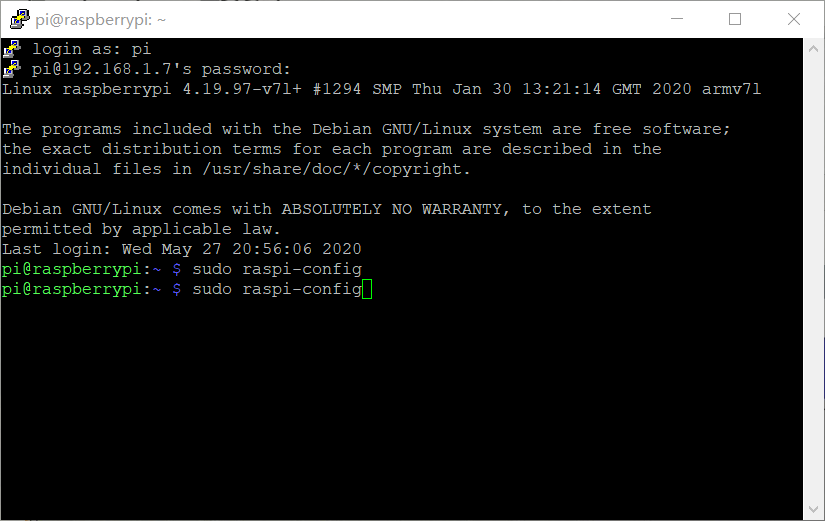
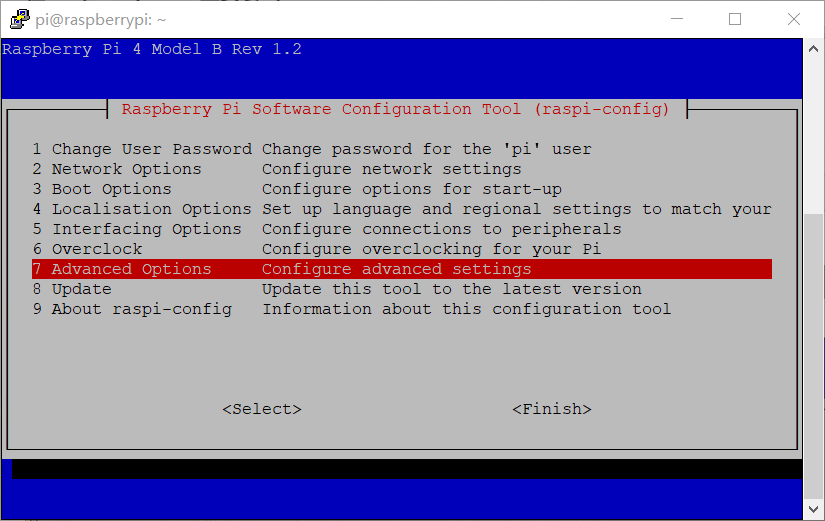
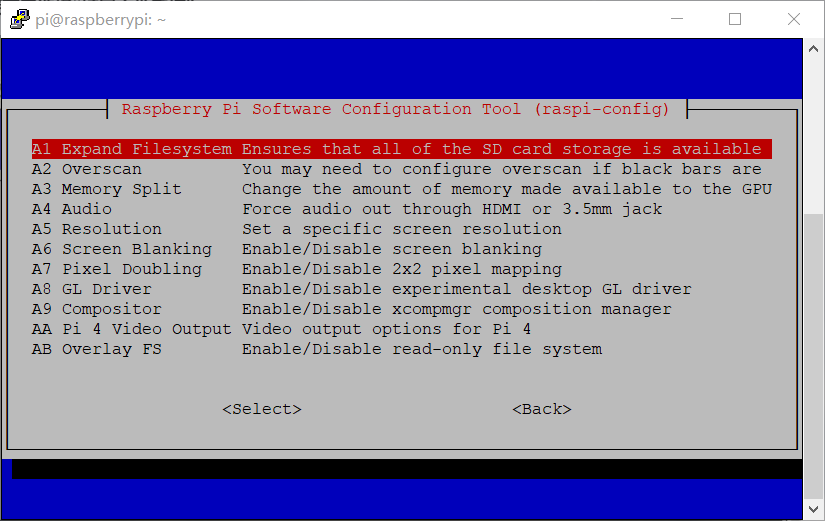
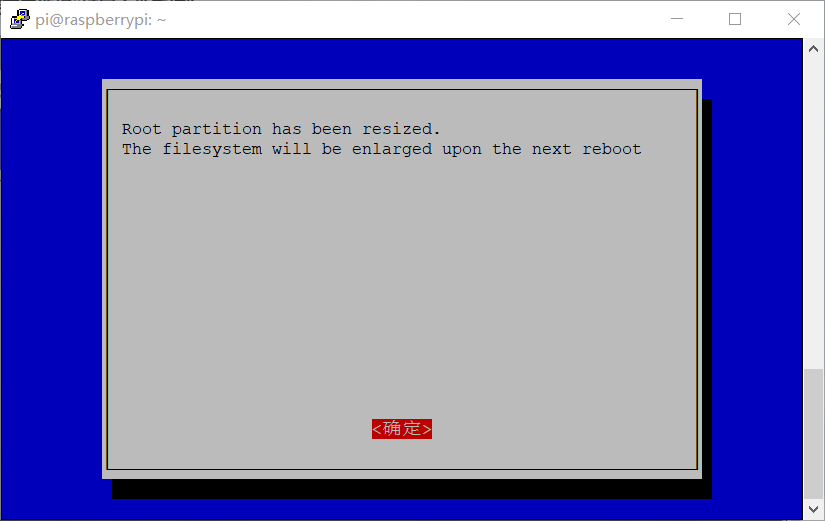
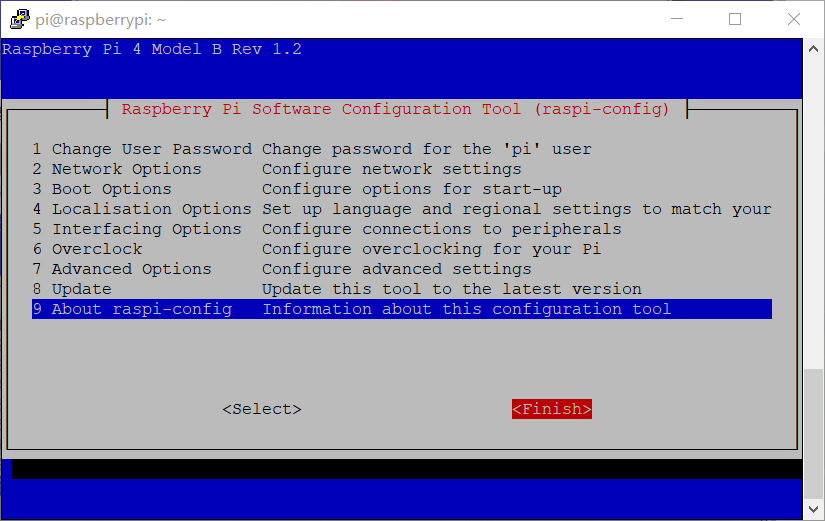

完成以上操作后,执行下面命令来重新启动pi:
sudo reboot
重新启动后,文件系统应已扩展为包括micro-SD卡上的所有可用空间。可以通过执行以下命令来验证磁盘是否已扩展并检查输出:
df -h
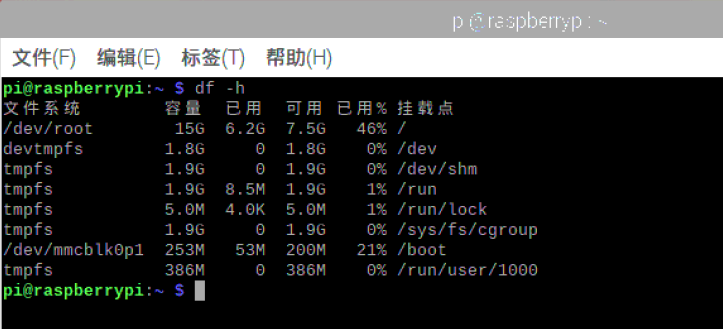
但是,即使扩展了文件系统,我也已经使用了15GB卡中的46%。因此,可以删除LibreOffice和Wolfram引擎以释放Pi上的一些空间:
sudo apt-get purge wolfram-engine
sudo apt-get purge libreoffice*
sudo apt-get clean
sudo apt-get autoremove

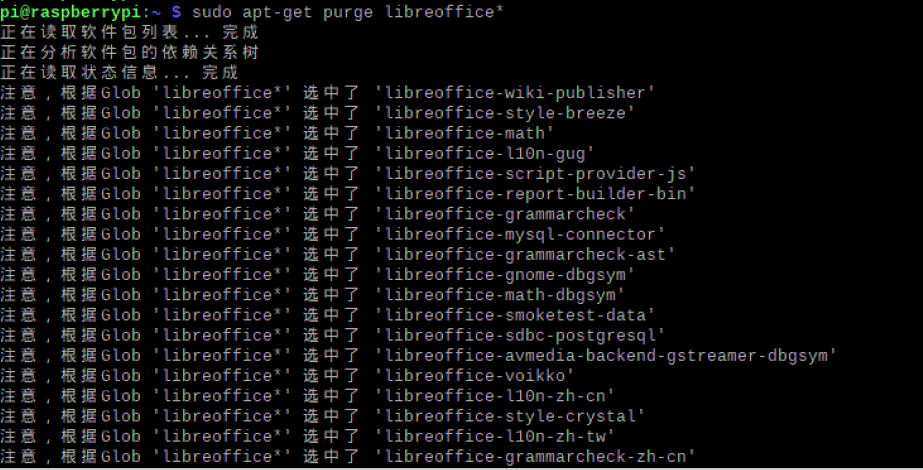
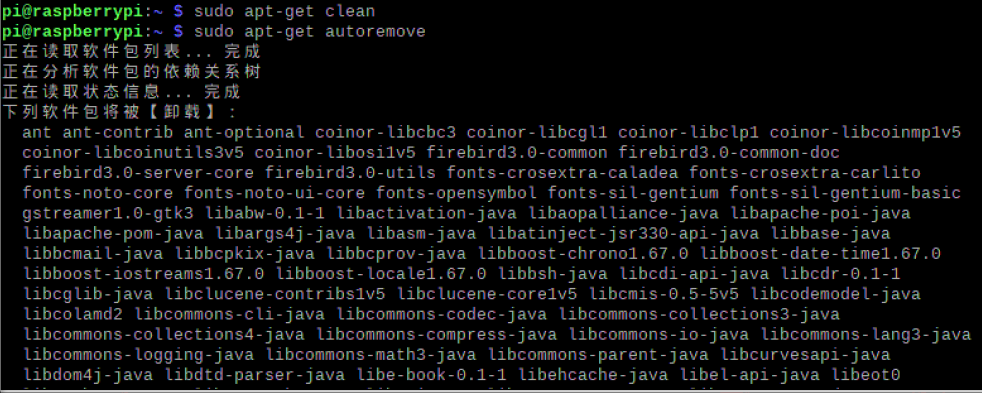

前后对比,多了2GB。做到这里基本没有什么问题。
步骤2:安装依赖项
在安装依赖包之前,建议先进行换清华源。不然很容易下着下着就崩了,很影响实验心情说实话。
注意:在更新前一定要安装 aptitude ,不然后面你可能会被“无法修正错误,因为您要求某些软件包保持现状,就是它们破坏了软件包间的依赖关系”这样的错误折磨发疯,aptitude 与 apt-get 一样,是 Debian 及其衍生系统中功能极其强大的包管理工具。与 apt-get 不同的是,aptitude 在处理依赖问题上更佳一些。举例来说,aptitude 在删除一个包时,会同时删除本身所依赖的包。这样,系统中不会残留无用的包,整个系统更为干净。树莓派在换源后,apt-get install 安装软件, 会报“无法修正错误,因为您要求某些软件包保持现状,就是它们破坏了软件包间的依赖关系”。这个错误出现的主要原因是,系统中已经安装了被依赖的包的高版本,并且版本高于所要求的这个版本,不匹配导致安装失败。虽然这种报错可以手动安装指定版本的软件包,但是各种互相依赖的一环套一环,会出现各种新的报错。
sudo apt-get install aptitude
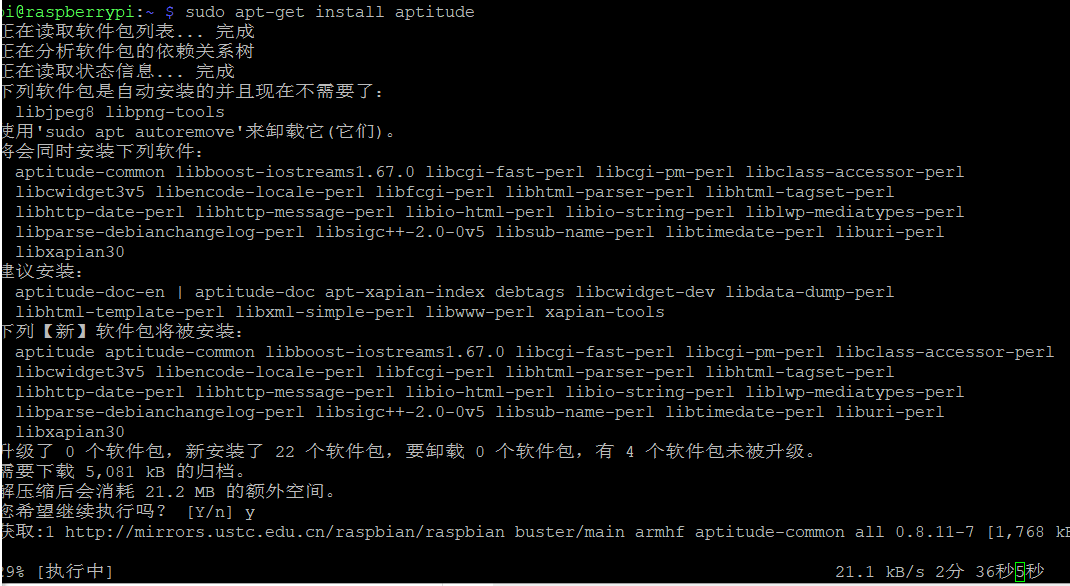
下载完aptitude之后,准备换源。执行以下命令,进行编辑系统源文件:
sudo nano /etc/apt/sources.list
将初始的源使用#注释掉,添加如下两行清华的镜像源。【注意】这里的树莓派系统是Raspbian-buster系统,在写系统源链接时要注意是buster,网上很多教程都是之前stretch版本,容易出错!
deb http://mirrors.tuna.tsinghua.edu.cn/raspbian/raspbian/ buster main contrib non-free rpi
deb-src http://mirrors.tuna.tsinghua.edu.cn/raspbian/raspbian/ buster main contrib non-free rpi
再更改系统源:
sudo nano /etc/apt/sources.list.d/raspi.list
用#注释掉原文件内容,用以下内容取代:
deb http://mirrors.tuna.tsinghua.edu.cn/raspberrypi/ buster main ui
deb-src http://mirrors.tuna.tsinghua.edu.cn/raspberrypi/ buster main ui
然后执行以下操作完成换源:
sudo apt-get update
sudo apt-get upgrade
可能会出现以下情况:


我直接跳过了,不理它。
这个部分参考这篇文章树莓派4B(Raspbian-buster系统)换清华源并更换系统源
然后安装开发工具CMake,帮助我们配置OpenCV构建过程
sudo apt-get install build-essential cmake pkg-config
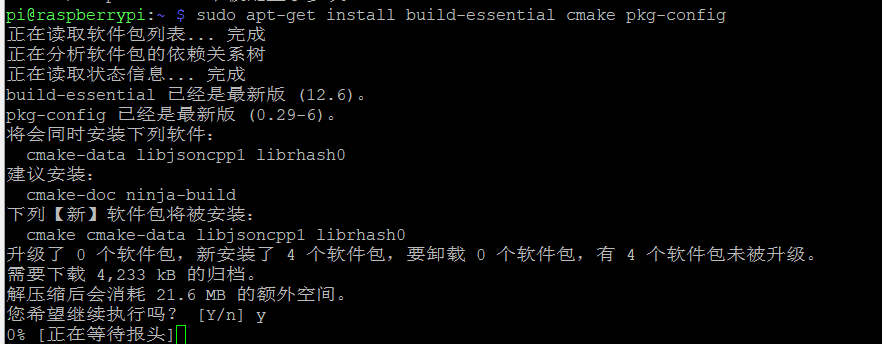
接着安装图像I/O包,允许我们从磁盘加载各种图像文件格式。这种文件格式的例子包括JPEG,PNG,TIFF等
sudo apt-get install libjpeg-dev libtiff5-dev libjasper-dev libpng12-dev

视频I/O包。这些库允许我们从磁盘读取各种视频文件格式,并直接处理视频流
sudo apt-get install libavcodec-dev libavformat-dev libswscale-dev libv4l-dev
sudo apt-get install libxvidcore-dev libx264-dev

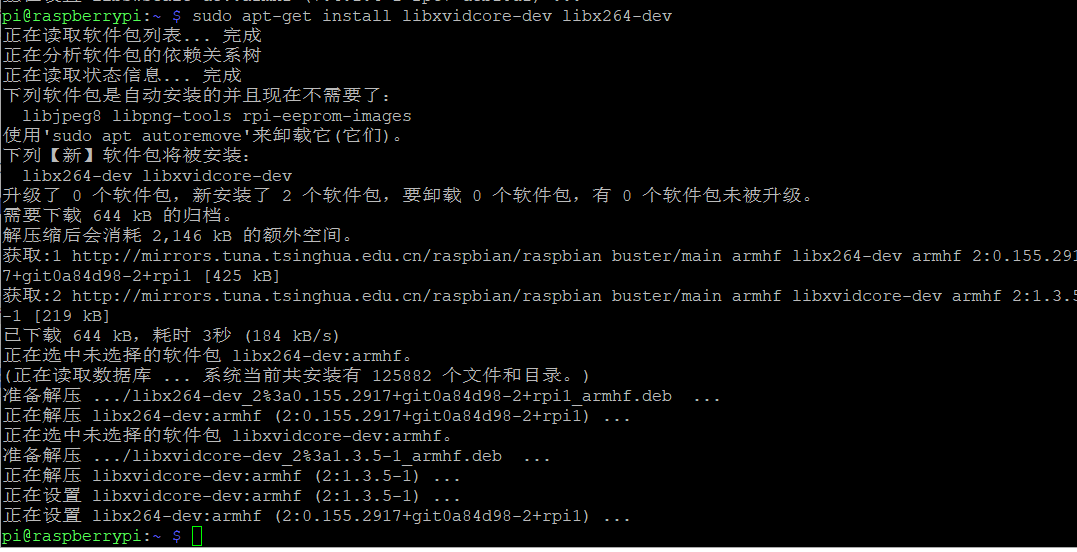
OpenCV库附带一个名为highgui的子模块 ,用于在我们的屏幕上显示图像并构建基本的GUI。为了编译 highgui模块,我们需要安装GTK开发库
sudo apt-get install libgtk2.0-dev libgtk-3-dev

OpenCV中的许多操作(即矩阵操作)可以通过安装一些额外的依赖关系进一步优化
sudo apt-get install libatlas-base-dev gfortran

安装Python 2.7和Python 3头文件,以便我们可以用Python绑定来编译OpenCV
sudo apt-get install python2.7-dev python3-dev

做到这里,这一部分遇到问题如下:
问题一:在参考Raspbian Stretch: Install OpenCV 3 + Python on your Raspberry Pi这篇文档,执行sudo apt-get update && sudo apt-get upgrade 来更新所有软件包时,下载速度贼慢,最后挂掉。(在没换清华源之前,我是用了阿里源,不知道是不是我阿里源没配置好的问题)。
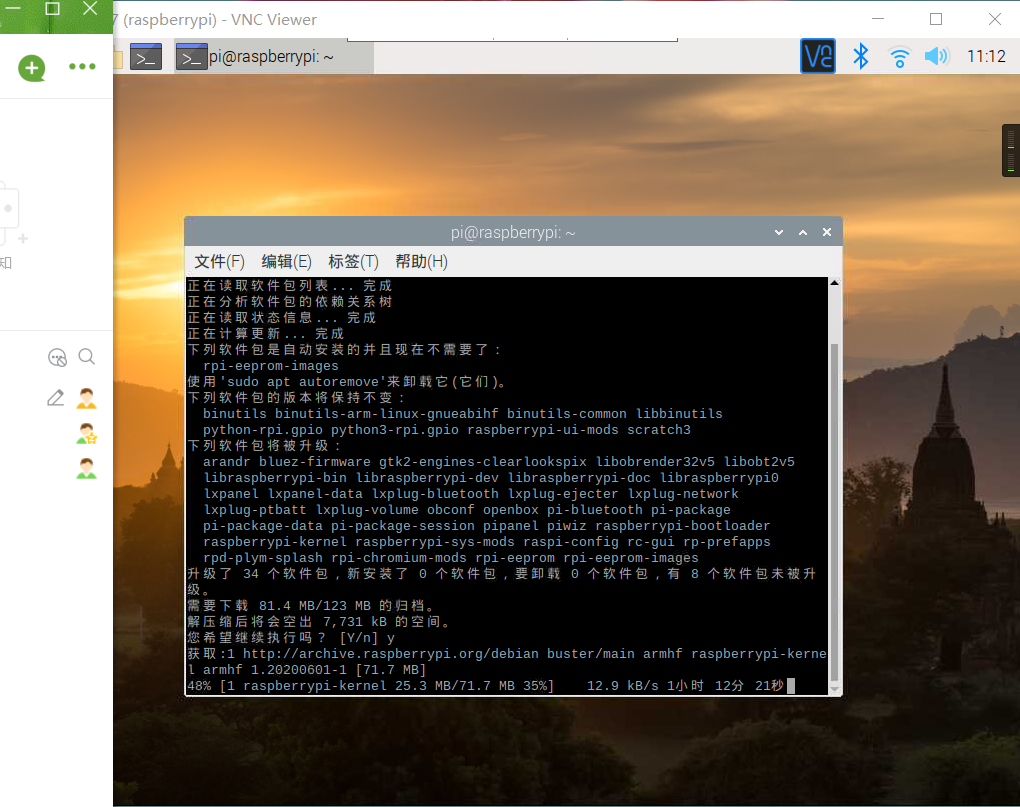
解决方案:其实在换清华源之前,我是使用的是阿里源,然后换成了中科大源,可是在接下来遇到了问题,不得不再一次换源。(我觉得应该是我换中科大源的时候没配置好)。所以建议,一步到位,按我上面的方法直接换成清华源。
问题二:在没换清华源以及下载aptitude之前,执行sudo apt-get install libavcodec-dev libavformat-dev libswscale-dev libv4l-dev命令后,出现包与包之间依赖的问题。
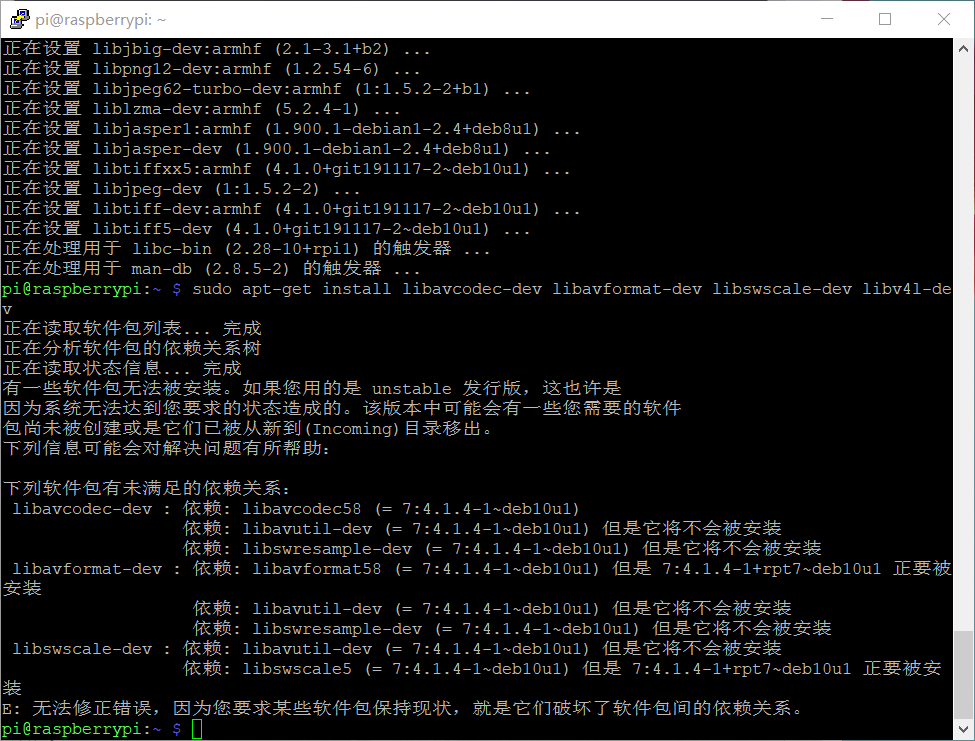
解决方案:先下载aptitude,再换成清华源,就解决了。清华源真香!
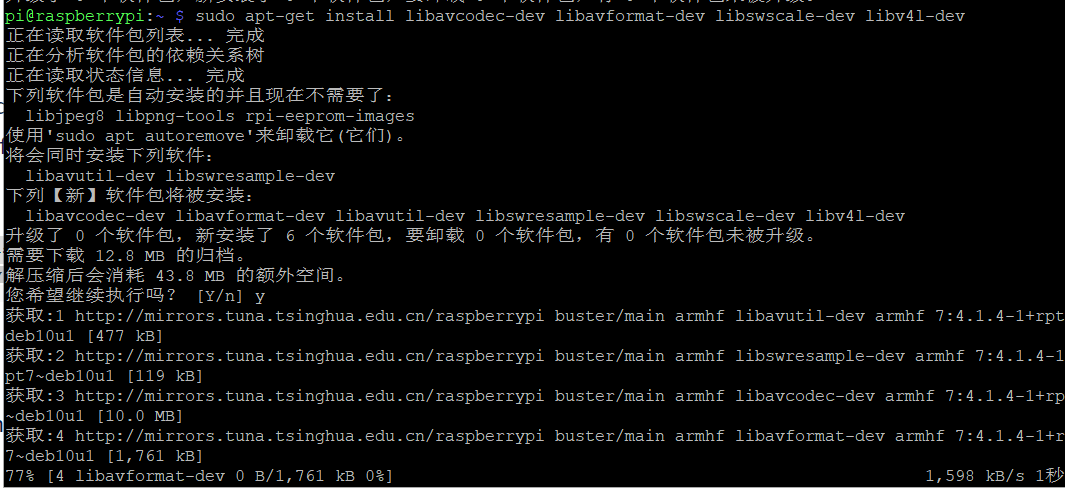
步骤#3:下载OpenCV源代码
现在我们已经安装了依赖项,从官方的OpenCV仓库中获取OpenCV 的 4.1.2归档。
cd ~
wget -O opencv.zip https://github.com/Itseez/opencv/archive/4.1.2.zip
unzip opencv.zip
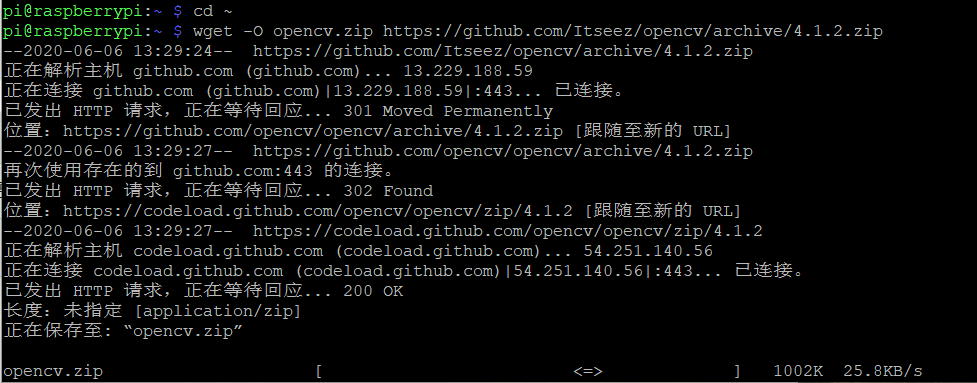
我们需要完整安装 OpenCV 3(例如,可以访问SIFT和SURF等功能),因此我们还需要获取opencv_contrib存储库。注意:确保 opencv和opencv_contrib版本相同。如果版本号不匹配,那么可能会遇到编译时错误或运行时错误。
wget -O opencv_contrib.zip https://github.com/Itseez/opencv_contrib/archive/4.1.2.zip
unzip opencv_contrib.zip
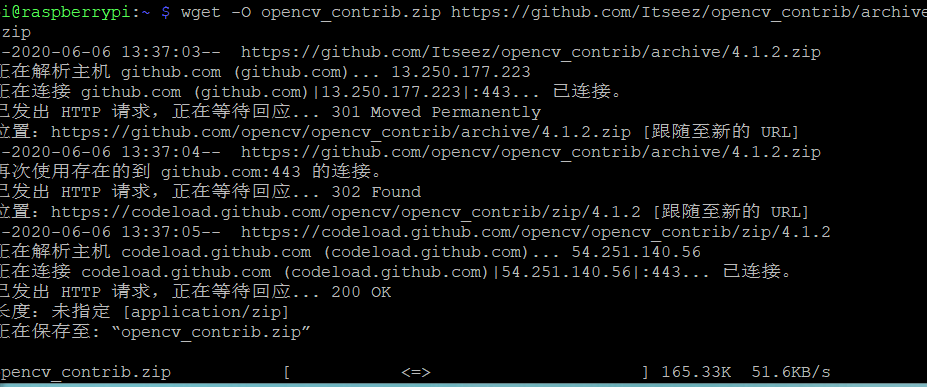
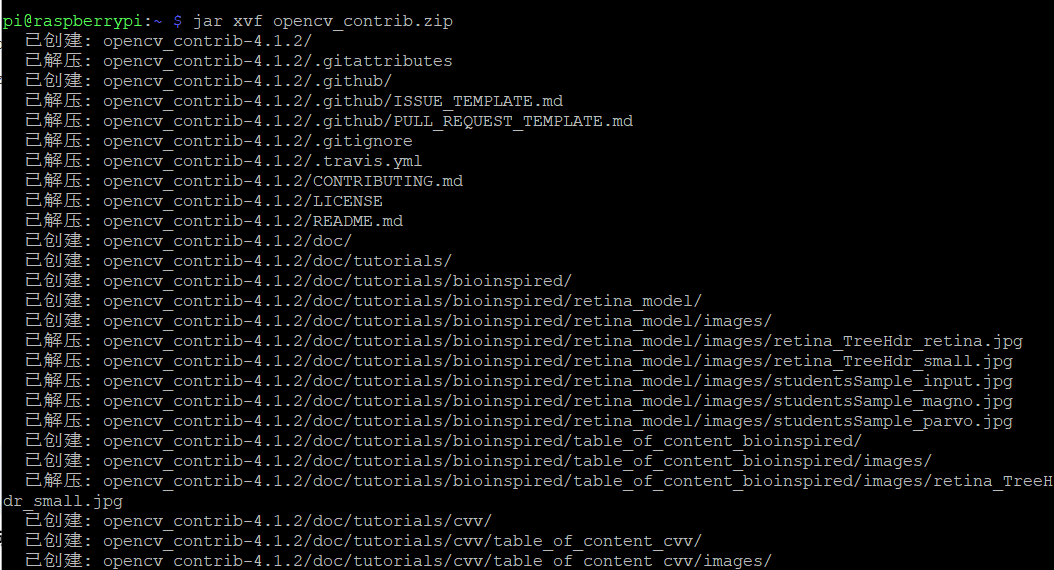
这里我在执行unzip xxx.zip的时候出现问题
问题三:


解决方案:参考这篇博客在Linux中使用unzip打开zip文件失败。也有博客写着下载7zip来解压.zip文件,我这个方法试了,结果出现新的问题,所以不建议采用。
步骤4:Python 2.7或Python 3?
首先需要安装 Python包管理器pip:
wget https://bootstrap.pypa.io/get-pip.py
sudo python get-pip.py
sudo python3 get-pip.py


接下来安装virtualenv和 virtualenvwrapper,这里与文档给出的命令有些不一样,因为按文档的命令执行会出现一些问题,建议改成下面命令。
sudo pip3 install virtualenv virtualenvwrapper=='4.8.4'
sudo rm -rf ~/.cache/pip
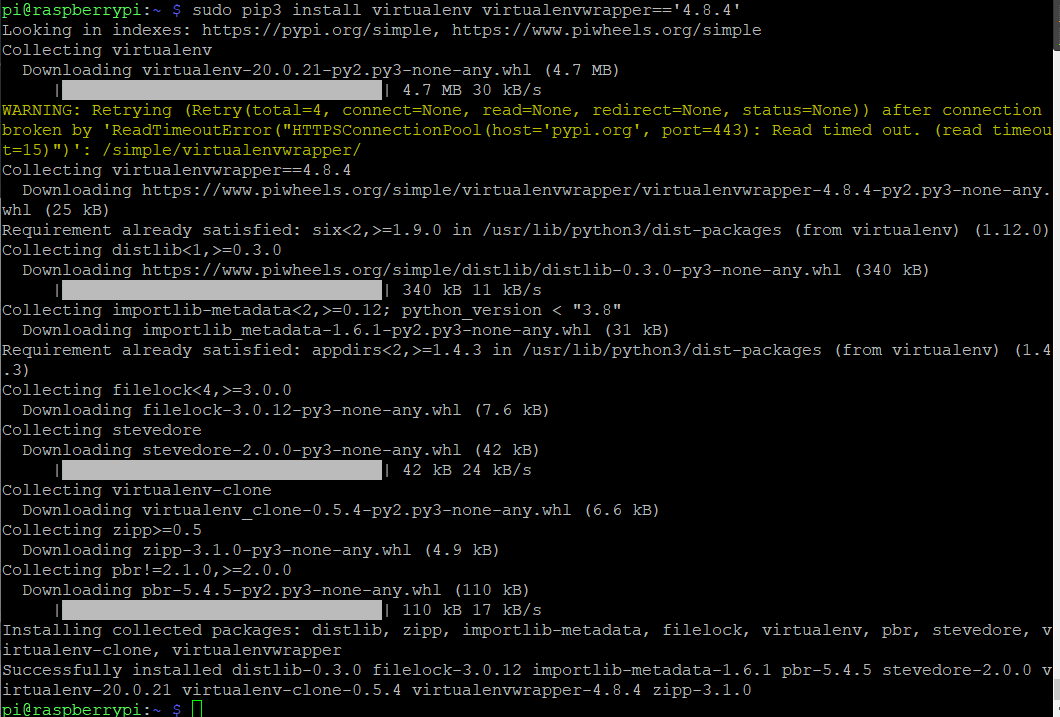
配置~/.profile,添加内容:(这里建议下载一个VIM,方便编辑)
export WORKON_HOME=$HOME/.virtualenvs
export VIRTUALENVWRAPPER_PYTHON=/usr/bin/python3
source /usr/local/bin/virtualenvwrapper.sh

使之生效:
source ~/.profile
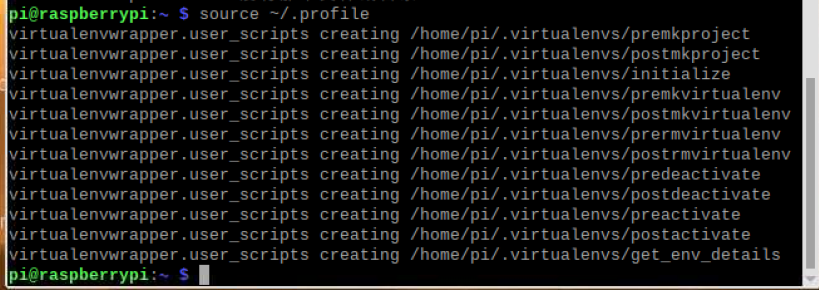
使用Python3 安装虚拟机:
mkvirtualenv cv -p python3
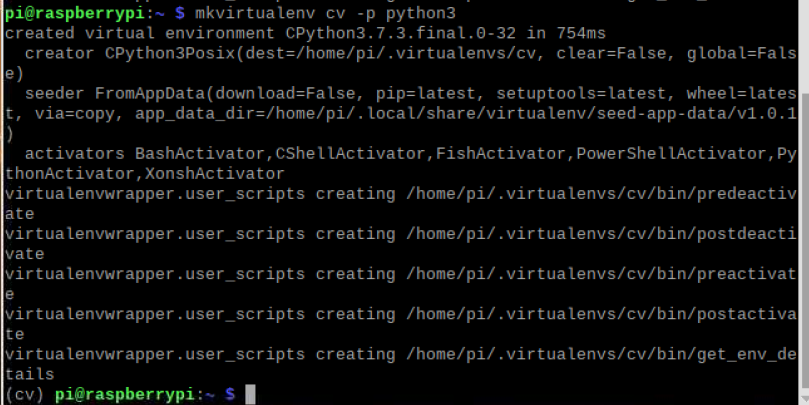
虚拟机完成安装之后,后续的所有操作全部在虚拟机中进行。按照教程的说明,一定要看清楚命令行前面是否有(cv),以此作为是否在虚拟机的判断!
需要重新进入虚拟机,可运行下面的命令:
source ~/.profile
workon cv
接下来的操作都是在虚拟机中进行
安装numpy:
pip install numpy
执行上面的命令,我又出问题了:
问题四:安装超时。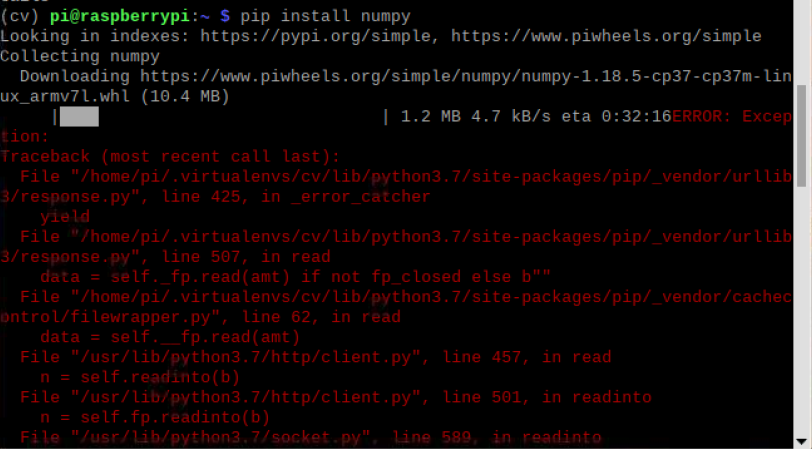
解决方案:参考博客python pip安装第三方库超时问题
更改命令:
pip install -i https://pypi.tuna.tsinghua.edu.cn/simple numpy

步骤5:编译并安装OpenCV
cd ~/opencv-4.1.2/
mkdir build
cd build
cmake -D CMAKE_BUILD_TYPE=RELEASE
-D CMAKE_INSTALL_PREFIX=/usr/local
-D INSTALL_PYTHON_EXAMPLES=ON
-D OPENCV_EXTRA_MODULES_PATH=~/opencv_contrib-4.1.2/modules
-D BUILD_EXAMPLES=ON ..
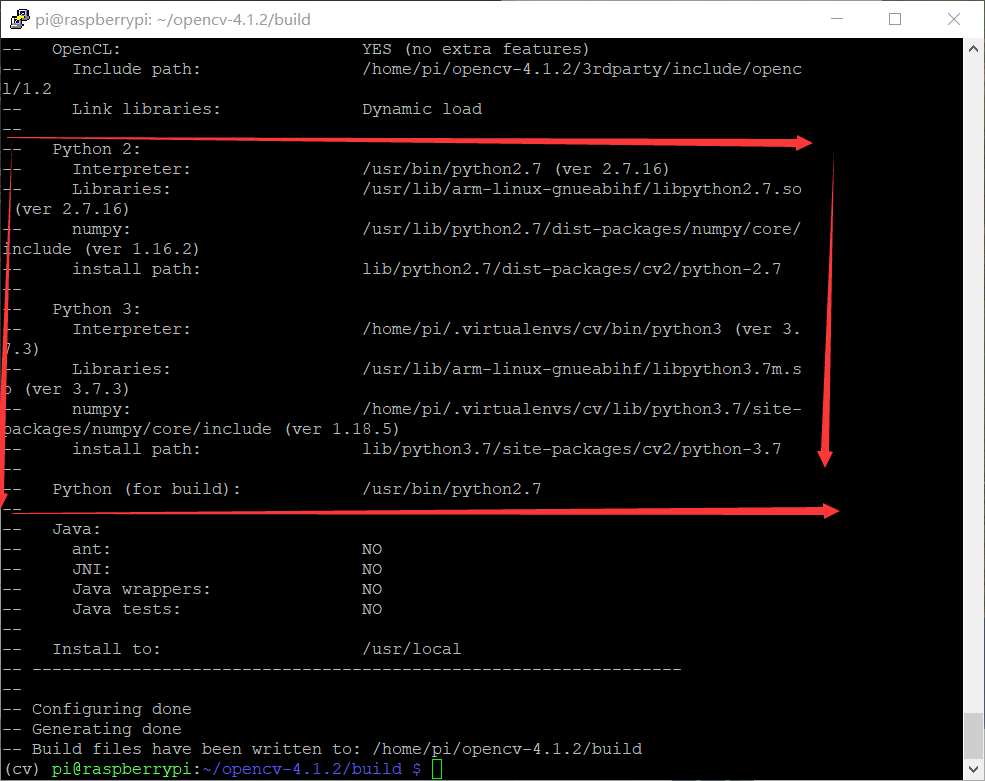
编译之前配置交换空间大小。这使OpenCV可以使用 Raspberry PI的所有四个内核进行编译,而不会由于内存问题而挂起编译。把交换空间交换空间增大到 CONF_SWAPSIZE=1024。

注意:vim保存修改只读文件命令为(:w !sudo tee %)。在终端输入的时候没有括号。
# 虚拟机中sudo才可以修改
sudo nano /etc/dphys-swapfile
sudo /etc/init.d/dphys-swapfile stop
sudo /etc/init.d/dphys-swapfile start
# 开始编译(近2个小时吧)
make
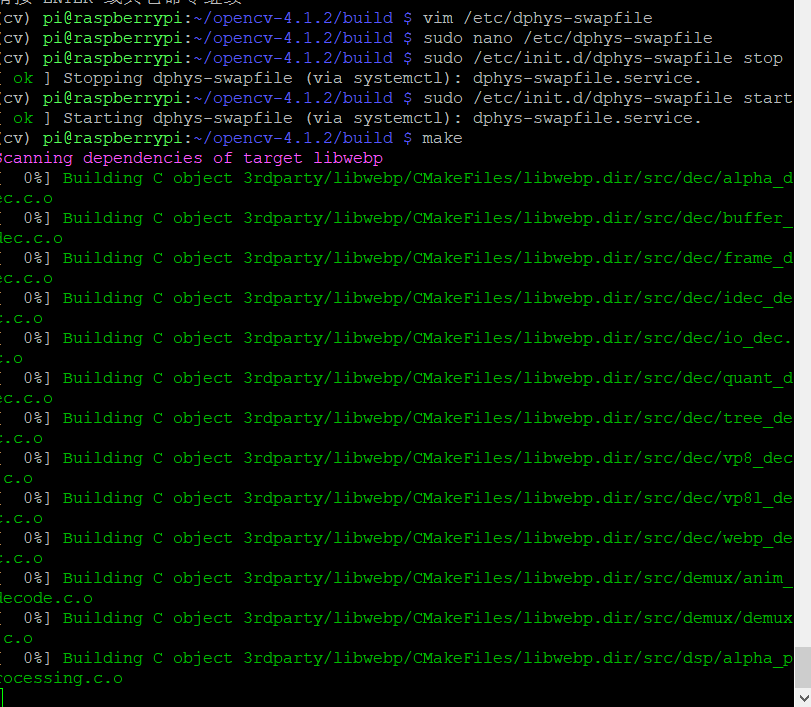
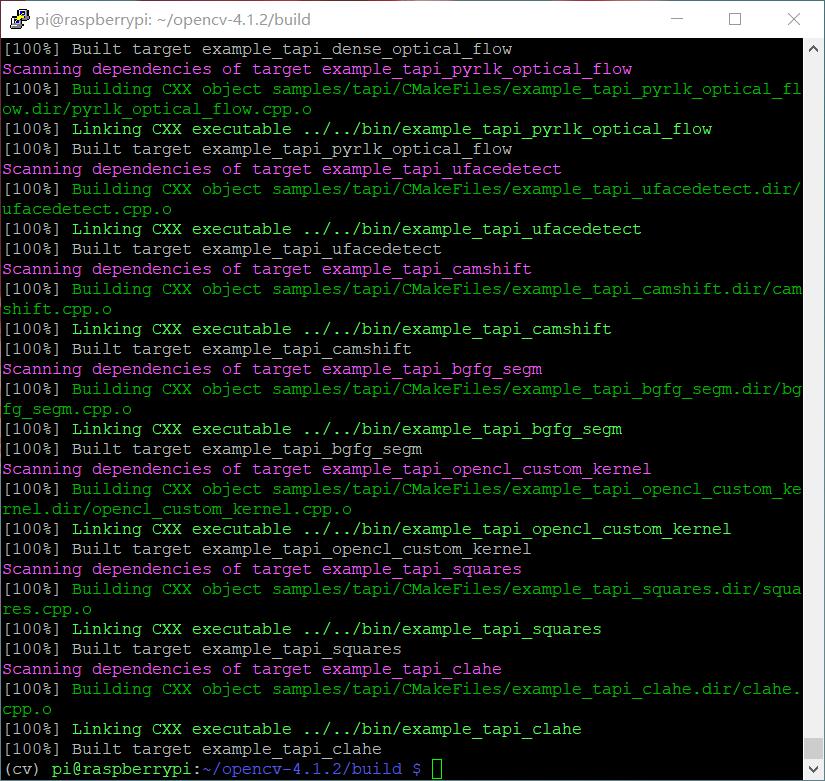
步骤6:完成在Pi上安装OpenCV
sudo make install
sudo ldconfig

检查OpenCV的安装位置
ls -l /usr/local/lib/python3.7/site-packages/
cd ~/.virtualenvs/cv/lib/python3.7/site-packages/
ln -s /usr/local/lib/python3.7/site-packages/cv2 cv2

验证安装:
source ~/.profile
workon cv
python
import cv2
cv2.__version__

最后打开你的 /etc/dphys-swapfile 然后把 CONF_SWAPSIZE改回100。

实验二、使用opencv和python控制树莓派的摄像头
1.安装picreame
source ~/.profile
workon cv
pip install "picamera[array]"
2.实例代码
test_image.py
# import the necessary packages
from picamera.array import PiRGBArray
from picamera import PiCamera
import time
import cv2
# initialize the camera and grab a reference to the raw camera capture
camera = PiCamera()
rawCapture = PiRGBArray(camera)
# allow the camera to warmup
time.sleep(2)
# grab an image from the camera
camera.capture(rawCapture, format="bgr")
image = rawCapture.array
# display the image on screen and wait for a keypress
cv2.imshow("Image", image)
cv2.waitKey(0)

实验三、利用树莓派的摄像头实现人脸识别
1、安装依赖库dlib,face_recognition
pip install dlib
pip install face_recognition
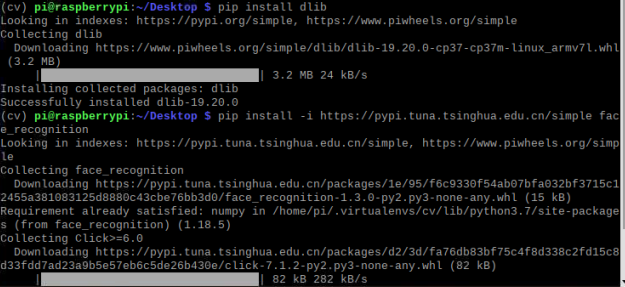
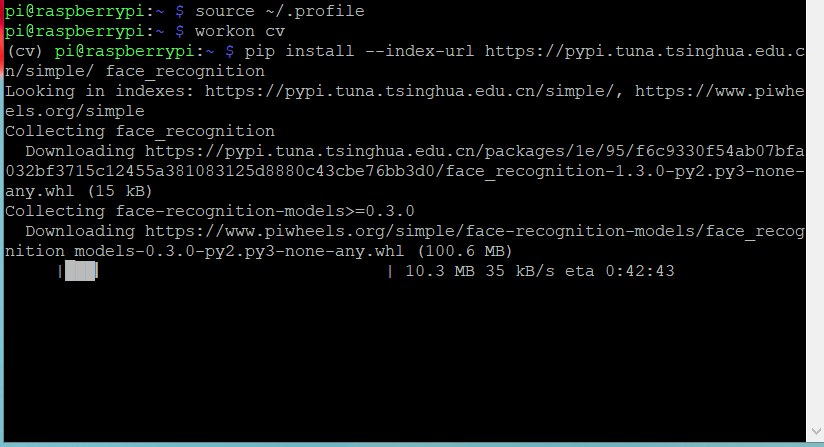
2、facerec_on_raspberry_pi.py
# This is a demo of running face recognition on a Raspberry Pi.
# This program will print out the names of anyone it recognizes to the console.
# To run this, you need a Raspberry Pi 2 (or greater) with face_recognition and
# the picamera[array] module installed.
# You can follow this installation instructions to get your RPi set up:
# https://gist.github.com/ageitgey/1ac8dbe8572f3f533df6269dab35df65
import face_recognition
import picamera
import numpy as np
# Get a reference to the Raspberry Pi camera.
# If this fails, make sure you have a camera connected to the RPi and that you
# enabled your camera in raspi-config and rebooted first.
camera = picamera.PiCamera()
camera.resolution = (320, 240)
output = np.empty((240, 320, 3), dtype=np.uint8)
# Load a sample picture and learn how to recognize it.
print("Loading known face image(s)")
Lilianjie_image = face_recognition.load_image_file("Lilianjie.jpg")
Lilianjie_face_encoding = face_recognition.face_encodings(Lilianjie_image)[0]
# Initialize some variables
face_locations = []
face_encodings = []
while True:
print("Capturing image.")
# Grab a single frame of video from the RPi camera as a numpy array
camera.capture(output, format="rgb")
# Find all the faces and face encodings in the current frame of video
face_locations = face_recognition.face_locations(output)
print("Found {} faces in image.".format(len(face_locations)))
face_encodings = face_recognition.face_encodings(output, face_locations)
# Loop over each face found in the frame to see if it's someone we know.
for face_encoding in face_encodings:
# See if the face is a match for the known face(s)
match = face_recognition.compare_faces([Lilianjie_face_encoding], face_encoding)
name = "<Unknown Person>"
if match[0]:
name = "Lilianjie"
print("I see someone named {}!".format(name))

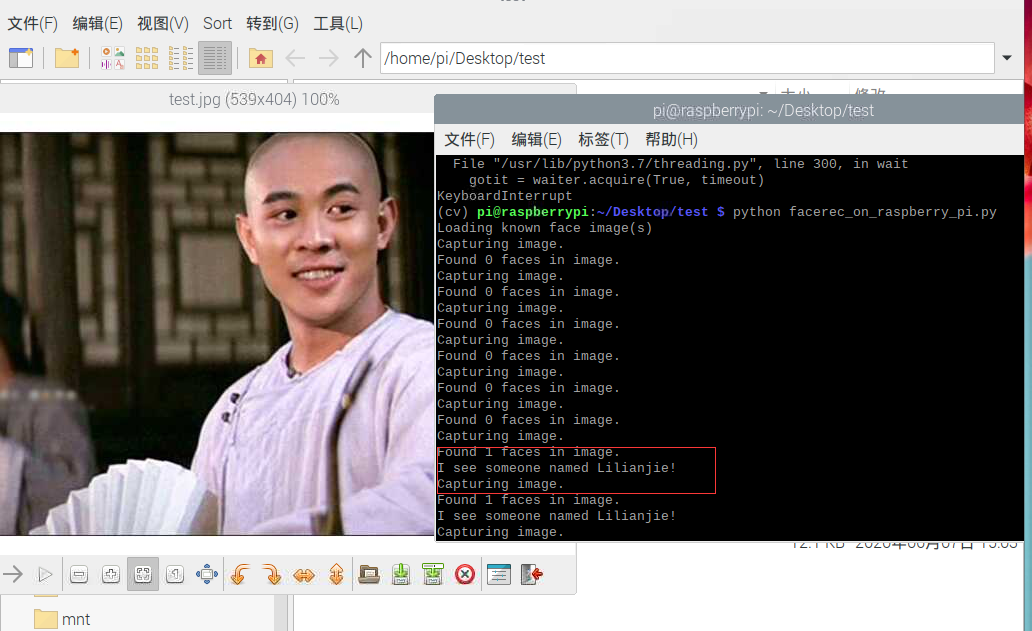
3、facerec_from_webcam_faster.py
import face_recognition
import cv2
import numpy as np
# This is a demo of running face recognition on live video from your webcam. It's a little more complicated than the
# other example, but it includes some basic performance tweaks to make things run a lot faster:
# 1. Process each video frame at 1/4 resolution (though still display it at full resolution)
# 2. Only detect faces in every other frame of video.
# PLEASE NOTE: This example requires OpenCV (the `cv2` library) to be installed only to read from your webcam.
# OpenCV is *not* required to use the face_recognition library. It's only required if you want to run this
# specific demo. If you have trouble installing it, try any of the other demos that don't require it instead.
# Get a reference to webcam #0 (the default one)
video_capture = cv2.VideoCapture(0)
# Load a sample picture and learn how to recognize it.
Lilianjie_image = face_recognition.load_image_file("Lilianjie.jpg")
Lilianjie_face_encoding = face_recognition.face_encodings(Lilianjie_image)[0]
# Load a second sample picture and learn how to recognize it.
Guanzhiling_image = face_recognition.load_image_file("Guanzhiling.jpg")
Guanzhiling_face_encoding = face_recognition.face_encodings(Guanzhiling_image)[0]
# Create arrays of known face encodings and their names
known_face_encodings = [
Lilianjie_face_encoding,
Guanzhiling_face_encoding
]
known_face_names = [
"Lilianjie",
"Guanzhiling"
]
# Initialize some variables
face_locations = []
face_encodings = []
face_names = []
process_this_frame = True
while True:
# Grab a single frame of video
ret, frame = video_capture.read()
# Resize frame of video to 1/4 size for faster face recognition processing
small_frame = cv2.resize(frame, (0, 0), fx=0.25, fy=0.25)
# Convert the image from BGR color (which OpenCV uses) to RGB color (which face_recognition uses)
rgb_small_frame = small_frame[:, :, ::-1]
# Only process every other frame of video to save time
if process_this_frame:
# Find all the faces and face encodings in the current frame of video
face_locations = face_recognition.face_locations(rgb_small_frame)
face_encodings = face_recognition.face_encodings(rgb_small_frame, face_locations)
face_names = []
for face_encoding in face_encodings:
# See if the face is a match for the known face(s)
matches = face_recognition.compare_faces(known_face_encodings, face_encoding)
name = "Unknown"
# # If a match was found in known_face_encodings, just use the first one.
# if True in matches:
# first_match_index = matches.index(True)
# name = known_face_names[first_match_index]
# Or instead, use the known face with the smallest distance to the new face
face_distances = face_recognition.face_distance(known_face_encodings, face_encoding)
best_match_index = np.argmin(face_distances)
if matches[best_match_index]:
name = known_face_names[best_match_index]
face_names.append(name)
process_this_frame = not process_this_frame
# Display the results
for (top, right, bottom, left), name in zip(face_locations, face_names):
# Scale back up face locations since the frame we detected in was scaled to 1/4 size
top *= 4
right *= 4
bottom *= 4
left *= 4
# Draw a box around the face
cv2.rectangle(frame, (left, top), (right, bottom), (0, 0, 255), 2)
# Draw a label with a name below the face
cv2.rectangle(frame, (left, bottom - 35), (right, bottom), (0, 0, 255), cv2.FILLED)
font = cv2.FONT_HERSHEY_DUPLEX
cv2.putText(frame, name, (left + 6, bottom - 6), font, 1.0, (255, 255, 255), 1)
# Display the resulting image
cv2.imshow('Video', frame)
# Hit 'q' on the keyboard to quit!
if cv2.waitKey(1) & 0xFF == ord('q'):
break
# Release handle to the webcam
video_capture.release()
cv2.destroyAllWindows()


实验四、结合微服务的进阶任务
安装Docker
下载安装脚本
curl -fsSL https://get.docker.com -o get-docker.sh
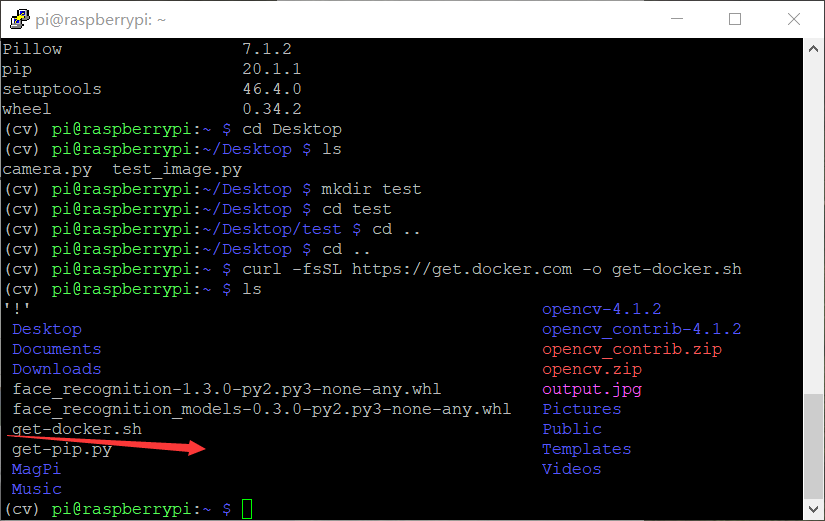
行安装脚本(阿里云镜像)
sh get-docker.sh --mirror Aliyun

查看docker版本,验证是否安装成功

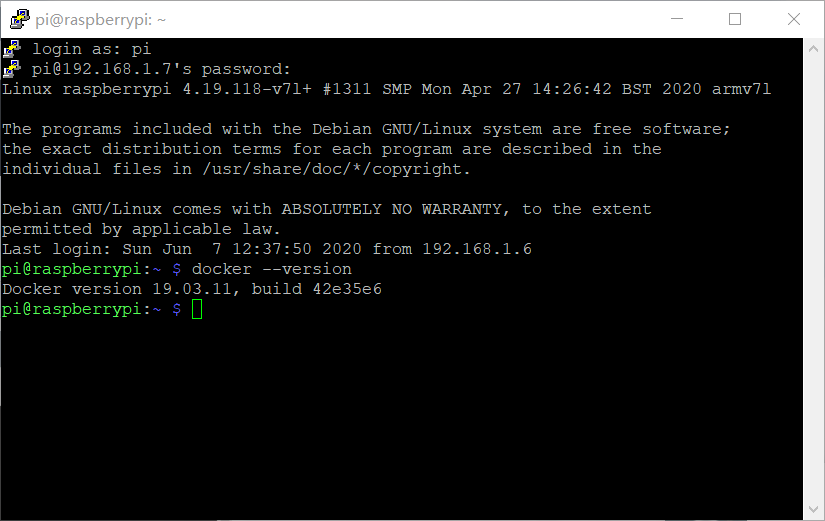
添加用户到docker组,然后重新登陆让用户组生效
sudo usermod -aG docker pi
定制opencv镜像
拉取镜像
docker pull sixsq/opencv-python
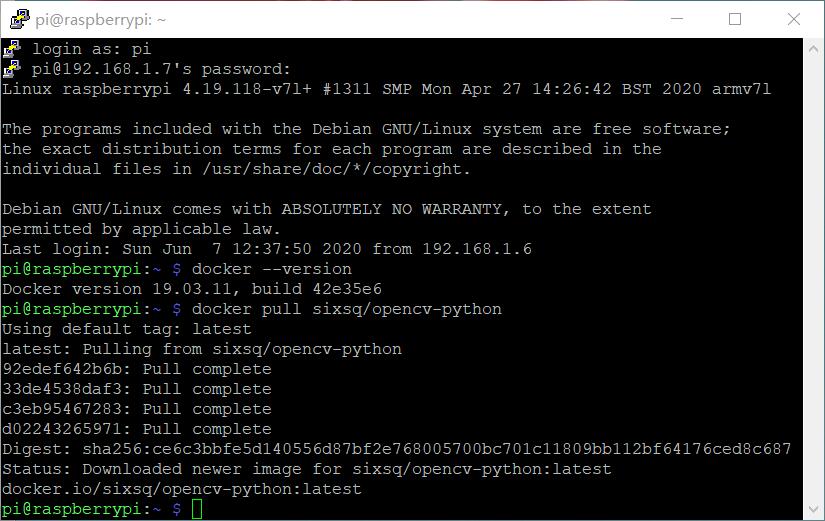
创建并运行容器
docker run -it sixsq/opencv-python /bin/bash

在容器中,用pip3安装 "picamera[array]",dlib和face_recognition
pip3 install "picamera[array]"
pip3 install dlib
pip3 install face_recognition
exit


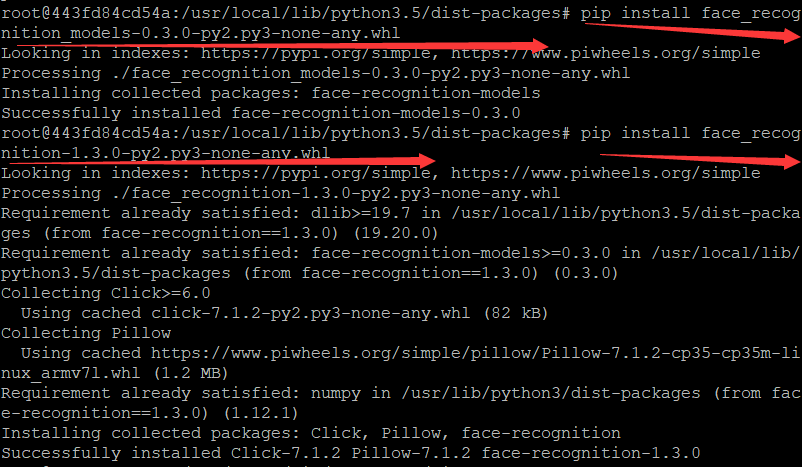
commit镜像

自定义镜像
Dockerfile
FROM opencv1
RUN mkdir /my
WORKDIR /my
COPY my .

构建镜像
docker build -t opencv2 .
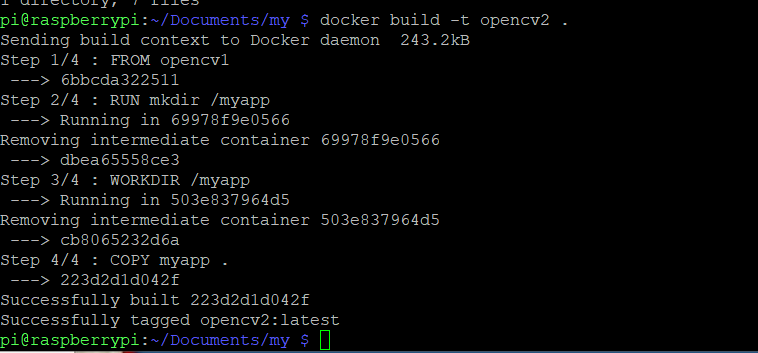

运行容器执行facerec_on_raspberry_pi.py
docker run -it --device=/dev/vchiq --device=/dev/video0 --name myopencv opencv2
python3 facerec_on_raspberry_pi.py


选做:
环境准备
在Windows系统中安装Xming和Putty安装好后,先打开Xming,然后打开Putty,开启树莓派的ssh配置中的X11
打开Putty后,把树莓派的IP地址填在下面这一栏里,端口用默认的就行了

查看DISPLAY环境变量值
注意:这个查看是在用Putty打开的窗口上查看到的,若直接在树莓派里的终端看,看到就是"DISPLAY=localhost:10.0"
printenv
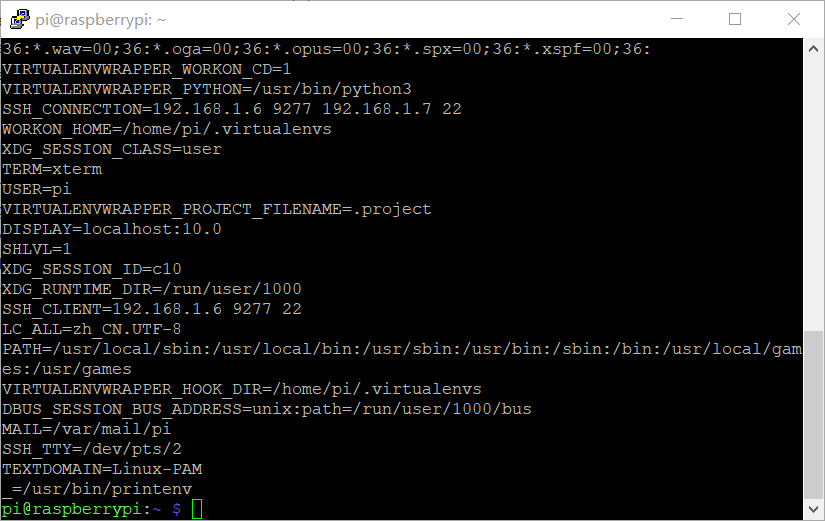
在用Putty打开的窗口上编写run.sh(路径在树莓派中的docker1文件夹
#sudo apt-get install x11-xserver-utils
xhost +
docker run -it
--net=host
-v $HOME/.Xauthority:/root/.Xauthority
-e DISPLAY=:10.0
-e QT_X11_NO_MITSHM=1
--device=/dev/vchiq
--device=/dev/video0
--name facerecgui
opencv2
python3 facerec_from_webcam_faster.py
打开终端,运行run.sh
sh run.sh

小组分工
| 学号 | 姓名 | 分工 |
| 031502115 | 黄 臻 | 查找资料,解决问题 |
| 031702243 | 杨成锦 | 动手操作,解决问题 |
| 031702218 | 覃鸿浩 | 查找资料,解决问题 |